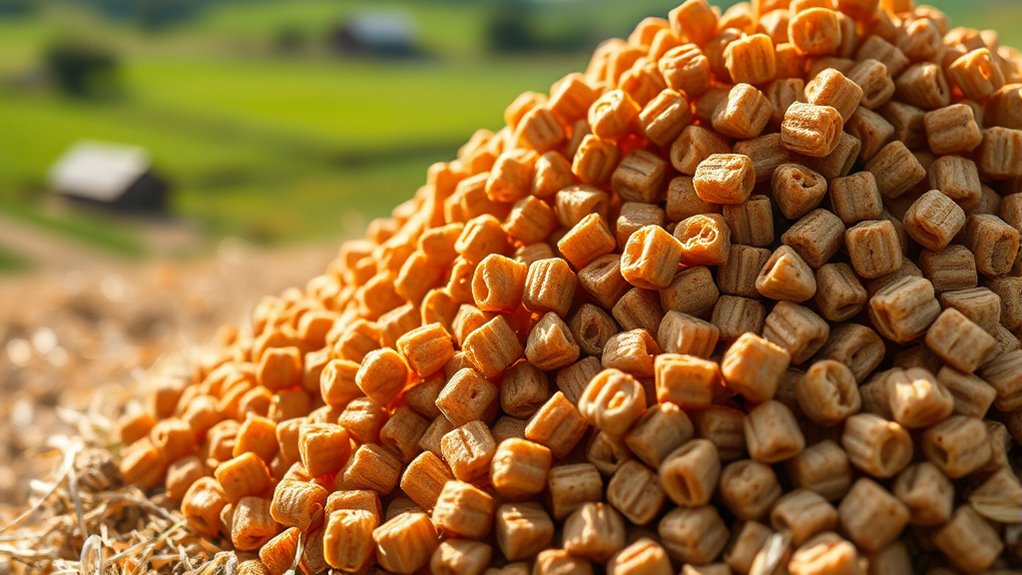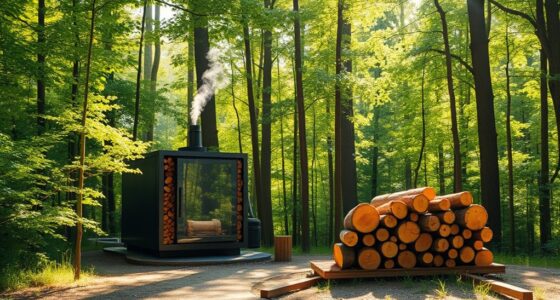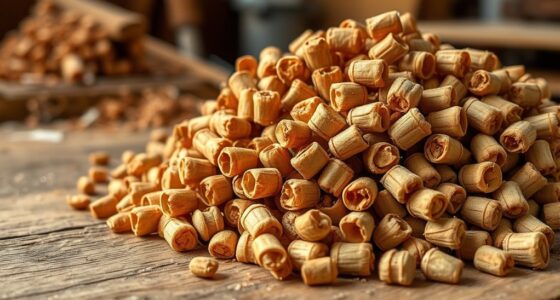Pellets from agricultural waste offer an eco-friendly, sustainable energy option you can use instead of traditional fossil fuels. By converting crop residue, husks, or straw into high-quality biomass pellets, you help reduce waste, lower greenhouse gas emissions, and support cleaner burning fuels with less ash. This process empowers farmers and communities to turn waste into income and energy, promoting a circular economy. If you want to discover how this innovative approach benefits both environment and economy, keep exploring.
Key Takeaways
- Agricultural waste pelletization transforms crop residues into clean, renewable fuel, reducing environmental impact.
- Produces eco-friendly pellets with less ash and smoke, supporting sustainable energy use.
- Promotes recycling of farm waste, decreasing reliance on fossil fuels and lowering greenhouse gas emissions.
- Supports local energy production, minimizing transportation emissions and boosting rural economies.
- Aligns with renewable energy goals by utilizing natural biomass for sustainable, eco-conscious heating solutions.

Agricultural waste, often considered a byproduct with little value, can be transformed into clean, efficient fuel through pelletization. Instead of letting leftover crop residue, husks, or straw go to waste, you can convert them into pellets that serve as a sustainable energy source. This process not only reduces waste but also supports eco-friendly practices in farming. By turning agricultural leftovers into fuel, you’re making strides toward sustainable farming, where resource efficiency is prioritized and environmental impact is minimized. These pellets can replace traditional fossil fuels, offering a renewable energy solution that helps cut greenhouse gas emissions and reliance on non-renewable resources.
Pelletizing agricultural waste is straightforward and cost-effective. You start by collecting the raw material—such as rice husks, wheat straw, or corn stalks—and drying it to ideal moisture levels. Once prepared, the material is compressed into dense pellets using specialized equipment. The resulting pellets are uniform in size, easy to handle, and burn efficiently. You’ll find that these pellets produce less ash and smoke compared to raw biomass, making them cleaner and more convenient for use in heating systems, boilers, or power plants. This process transforms what was once considered waste into a valuable commodity, maximizing resource utilization on your farm or community. Additionally, incorporating hybrid tuning techniques can optimize the combustion process for these pellets, improving efficiency and emissions. Incorporating quality control measures can further enhance pellet performance and consistency. Moreover, utilizing renewable biomass ensures that the energy source remains sustainable and environmentally friendly.
Pelletizing agricultural waste is simple, cost-effective, and transforms raw biomass into clean, efficient fuel.
Choosing to produce pellets from agricultural waste aligns perfectly with the principles of renewable energy. It’s a way to harness naturally available biomass, reducing dependence on fossil fuels. As you adopt pelletization, you contribute to a circular economy where waste is recycled into energy, fostering a more sustainable farming model. Furthermore, using local biomass reduces transportation emissions and supports community-based energy solutions. Additionally, since these pellets are made from locally sourced materials, you decrease transportation emissions and support local economies. This practice encourages farmers to view their crop residues not as mere leftovers but as potential income streams and energy resources, reinforcing sustainable farming practices that are environmentally and economically beneficial.
Furthermore, producing pellets from agricultural waste empowers you to adopt a cleaner energy lifestyle. It offers a practical alternative for heating and power generation, especially in rural areas where access to traditional fuels may be limited or expensive. By embracing pelletization, you’re taking a proactive step toward reducing your carbon footprint and promoting renewable energy sources. It’s a simple yet impactful way to turn agricultural waste into a valuable resource, making your farming operations more sustainable and environmentally responsible. In the end, pellets from agricultural waste aren’t just an eco-friendly option—they’re a smart, sustainable choice for a greener future.
Frequently Asked Questions
What Are the Main Types of Agricultural Waste Used for Pellets?
You can use crop residues like rice husks, wheat straw, and corn stalks, as well as orchard waste such as fruit peels and nut shells, to make pellets. These agricultural wastes are abundant and sustainable sources, making them ideal for eco-friendly pellet production. By converting this waste into pellets, you reduce landfill waste and create renewable energy, helping you contribute to environmental conservation.
How Does Pellet Production Impact Local Agricultural Economies?
Did you know that small-scale pellet production can boost local economies by up to 30%? By investing in pellet manufacturing from agricultural waste, you help create jobs and stimulate community development. This not only provides economic benefits but also encourages sustainable practices. You can see tangible improvements in local infrastructure and livelihoods, making agricultural waste a valuable resource that strengthens both the environment and your community’s financial health.
Are There Any Health Concerns Associated With Burning Agricultural Waste Pellets?
Burning agricultural waste pellets can impact your indoor air quality, potentially releasing fine particles and pollutants that might harm your respiratory health. You should ensure proper ventilation and use high-quality pellets to minimize emissions. While they’re a sustainable option, it is crucial to be aware of possible health concerns, especially if you have respiratory issues. Taking precautions helps protect your health while enjoying the benefits of eco-friendly pellet burning.
What Is the Typical Cost Comparison Between Biomass Pellets and Traditional Fuels?
Imagine savings blooming like a garden—biomass pellets often cost less than traditional fuels, giving you better cost efficiency. While initial prices might fluctuate with market tides, overall, pellets tend to be more budget-friendly and stable. You’ll find that harvesting agricultural waste transforms into a smart, eco-conscious choice that keeps your wallet and the planet happy, regardless of price fluctuations.
How Sustainable Is the Supply Chain for Agricultural Waste Pellets?
You can depend on the supply chain for agricultural waste pellets being quite sustainable when there’s strong supply chain resilience and waste collection efficiency. Efficient waste collection ensures a steady input of raw materials, while resilient logistics prevent disruptions. This combination helps maintain a consistent pellet supply, making it a dependable eco-friendly alternative. Plus, ongoing improvements in collection methods and infrastructure boost long-term sustainability, supporting your environmentally conscious choices.
Conclusion
Imagine turning agricultural waste into eco-friendly pellets that could revolutionize your energy use. As you consider this sustainable option, you’ll wonder what other surprising benefits it might hold. Could this small change make a big difference for the planet—and your wallet? The potential is vast, and the future is ripe with possibilities. Don’t miss out on discovering just how powerful these tiny pellets can be. The next step could change everything—are you ready to find out what’s next?











